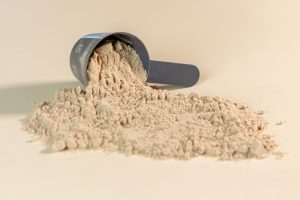Creatine is a popular dietary supplement used by athletes and fitness enthusiasts to enhance athletic performance and support muscle growth. Let’s dive in and explore what creatine is, when and how to use it effectively.
Creatine is a naturally occurring compound found in small amounts in certain foods and synthesized within the human body, primarily in the liver, kidneys, and pancreas. It plays a crucial role in providing energy during short bursts of high-intensity activities, such as weightlifting, sprinting, and jumping. Creatine is stored in the muscles in the form of creatine phosphate and is used to produce adenosine triphosphate (ATP), the primary energy currency of cells. As a popular dietary supplement, creatine is found in different types or forms available on the market places such as USN. Each type of creatine has its own characteristics, absorption rates, and potential benefits. Lets take a look at some of the most common types of creatine:
Creatine Monohydrate: This is the most widely researched and commonly used form of creatine. It consists of creatine molecules bound to a water molecule. Creatine monohydrate is known for its effectiveness, affordability, and safety. It has been extensively studied for its ability to improve athletic performance, muscle growth, and overall health. Creatine monohydrate is also found in the form of Micronized creatine that has smaller particle sizes. This is thought to improve mixing and solubility in liquid, making it easier to consume. It offers the same benefits as standard creatine monohydrate.
Creatine Ethyl Ester: This form of creatine is marketed as having improved absorption compared to creatine monohydrate. However, scientific research has shown mixed results regarding its effectiveness. Some users report less water retention and bloating with creatine ethyl ester, but it may not provide superior benefits over monohydrate.
Creatine Hydrochloride (HCL): Creatine HCL is another form of creatine that is claimed to have better solubility and absorption. It is often marketed as being more concentrated, requiring smaller doses. Like creatine ethyl ester, the scientific evidence supporting its superiority over creatine monohydrate is limited.
Buffered Creatine: Buffered creatine is created by combining creatine with an alkaline substance, such as sodium bicarbonate. It is said to have a higher pH level, which may reduce stomach discomfort and improve absorption. However, research on buffered creatine is still relatively limited compared to creatine monohydrate.
Creatine Nitrate: Creatine nitrate combines creatine with a nitrate molecule, which is thought to enhance vasodilation and blood flow. This form is marketed as providing both the benefits of creatine and improved pumps during workouts. Research on creatine nitrate is not as extensive as that of creatine monohydrate.
Kre-Alkalyn: Kre-Alkalyn is a patented form of creatine claimed to be more stable and less likely to convert into creatinine (a waste product) in the body. It is often marketed as requiring smaller doses due to its stability. However, scientific evidence supporting its superiority over creatine monohydrate is limited.
It’s important to note that while there are different types of creatine available, creatine monohydrate remains the most researched and proven form. It is typically the recommended choice for most individuals due to its established safety and effectiveness. When considering creatine supplementation, it’s a good idea to start of with creatine monohydrate no matter what your body goals are. I have used it for quite a while now and I don’t see myself stopping anytime soon.
When to Use Creatine:
Sports Performance: Creatine is most commonly used to improve performance in sports and activities that involve short bursts of intense effort, like weightlifting, sprinting, or powerlifting. It can enhance strength, power, and muscle endurance, potentially leading to better athletic performance.
Muscle Growth: Creatine may support muscle growth by increasing water content in muscle cells and promoting protein synthesis. This can lead to improved muscle fullness and size, making it a valuable supplement for those looking to build muscle mass.
Recovery: Numerous research has suggested that creatine supplementation can help reduce muscle damage and inflammation, potentially speeding up recovery between intense training sessions. However, you have to drink water in large amounts.
Brain Health: There is emerging evidence that creatine may have cognitive benefits and could be helpful for conditions involving brain function, like depression and cognitive decline. However, more research is needed in this area.
how to use creatine:
Dosage: A common dosing strategy is to take 3-5 grams of creatine monohydrate per day. Some people opt for a “loading phase” of 20 grams per day for the first 5-7 days to saturate muscle stores more quickly, followed by a maintenance dose of 3-5 grams per day. However, the loading phase is not necessary, and you can achieve the same results with a lower, consistent daily dose. Remember, consistency is key.
Timing: Creatine can be taken at any time during the day. Some individuals prefer to take it post-workout, while others take it with a meal. The key is to maintain a consistent daily intake.
Form: Creatine monohydrate is the most researched and widely used form of creatine. It is cost-effective and highly effective. Other forms, like creatine hydrochloride or creatine ethyl ester, may have varying degrees of effectiveness and are not as well-researched.
Hydration: Creatine may increase water retention in muscle cells, so it’s essential to stay adequately hydrated when using creatine to prevent cramping or discomfort.
With all that said, creatine is a widely used supplement known for its potential benefits in enhancing athletic performance, promoting muscle growth, and supporting recovery. When used appropriately and in combination with a well-balanced diet and training program, creatine can be a valuable tool for individuals looking to optimize their physical performance and muscle development.
Remember to, Flex at ur Prime.





A very informative article . Thank you.